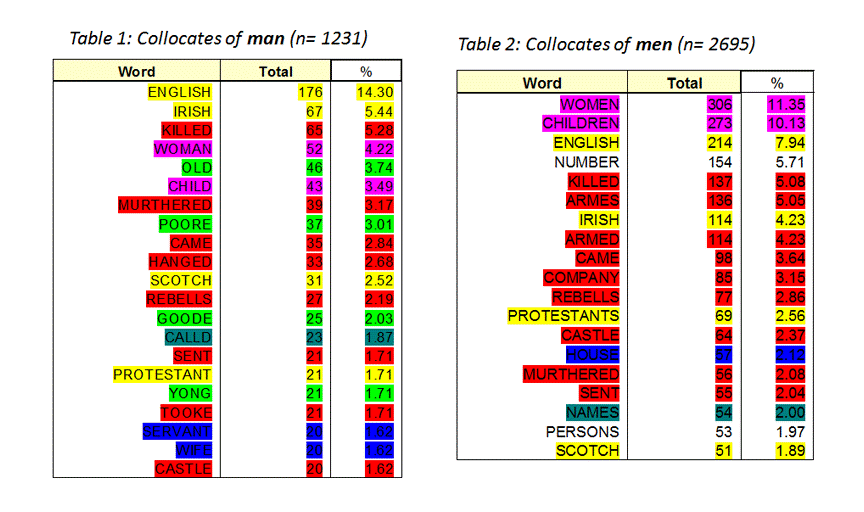Women in the 1641 Depositions
Examining the relative collocates of a set of labels attributed to women in the Depositions allows us to draw out and comment upon the ways in which these ‘types’ of women are written about, and how their role in events is constructed.
The first observation to be made is that the overall totals for woman and women are substantially lower than the corresponding figures for man and men, thus constructing them as less visible in relation to reportable events. The next step is to identify the fields to which the collocates belong, and to this end a semantic classification system was developed. See tables below:


As the tables show, there is perhaps unsurprisingly a heavier emphasis on domestic and familial roles (highlighted in blue) for 'woman' than for 'man'. The prevalence of items relating to violence and military action (marked in red) is strikingly greater in the male lists as compared to the female. There are further contrasts in the way this group of items are used in relation to men and women.
An examination of WordSmith's output reveals that while the most frequent position for 'killed' in relation to 'men' is two places to the right, for women it is four places to the left. Furthermore, while 'killed' is quite evenly distributed between left and right positions for men, for women the overwhelming majority occur to the left. A look at some concordance lines takes us some way towards understanding the significance of this difference. See concordance lines below:


Firstly, and perhaps unsurprisingly, men are presented as the Actor in the material process of killing, and this accounts for a number of the concordances where killed appears to the right. But other examples show the men as the recipients of the action of killing, yet killing still appears to the right - the choice has been made to represent the events through a passive construction, eg. 'four men were killed'. The tendency for the verb to appear to the left of ;'women', on the other hand, indicates that a grammatically active construction is preferred in these cases, and we might want to consider possible reasons for this.
It has been noted that passive constructions are an effective means of obscuring agency (Clark, 1992; Ehrlich, 2001). Given that the authors may be motivated to represent English men as empowered, and that violence against women had become central to the ideological construction of the barbarism of the Catholic rebels, there is a distinct possibility that these grammatical constructions are reflective of these motivations. It has been suggested by Purkiss (2005) that the mythologized depiction of extreme violence against women was designed to reassure the male population: in constructing women as passive recipients of violence it allowed for men to view themselves as different, as active and able to engage in military action on behalf of those more vulnerable. Presenting women as indisputable victims while men's victimhood is backgrounded is an effective means of addressing these needs.


